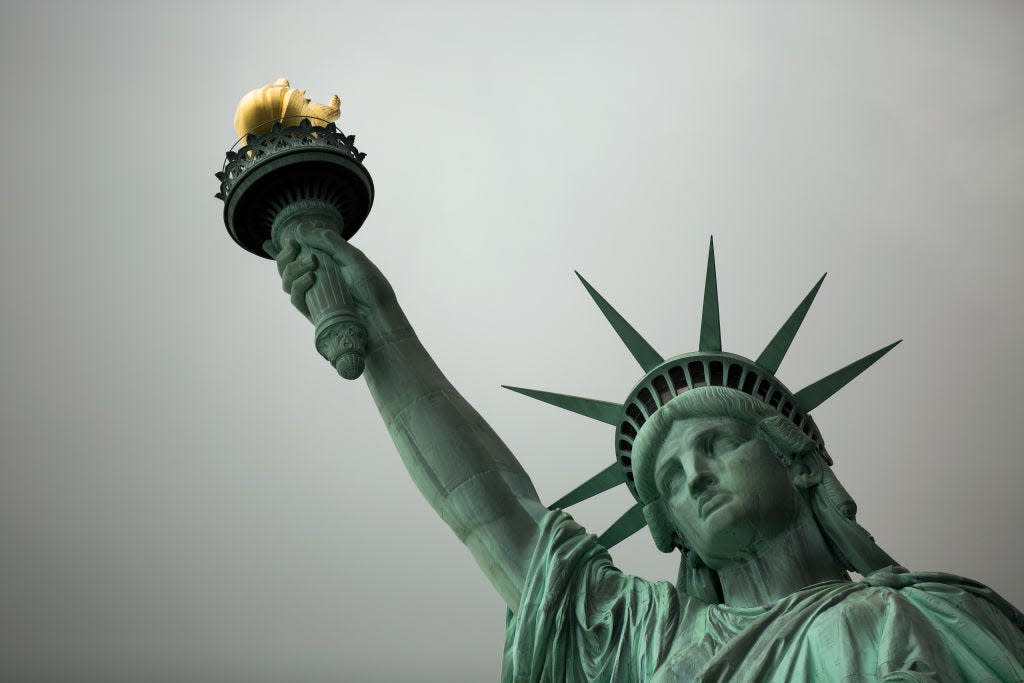US is and will always be a nation of immigrants. What will it take to update the system?

- Oops!Something went wrong.Please try again later.
Over 86 million people legally immigrated to the United States between 1783 and 2019. Conflicting visions and piecemeal legislation over the years have left the United States with a piecemeal immigration system developed over the years. The major problem with America’s southern border is an out-of-date immigration system while dealing with a record-setting number of migrants.
In 1952, President Harry S. Truman lamented that “in no other realm of our national life are we so hampered and stultified by the dead hand of the past as we are in this field of immigration.” From the colonial period through the Industrial Revolution, the Roaring '20s, the Great Depression and up to now, many of the debates, public responses and political accusations have been the same.
The question arises as to why America needs an immigration system today. Immigration is primarily related to economics. Secondly, it is a humanitarian program. People are the resources that build and protect nations. Wars, diseases and many other factors reduce a nation’s population. A nation’s immigration program offsets the loss of people and much needed skills.
Initially, immigration was a method of populating and growing the original American colonies. Individuals from different countries arrived by very various paths. Some were forced to immigrate, either through transportation or slavery, while others came voluntarily. Transportation was a British term for forced immigration used to expel its social undesirables, criminals and others to populate its American colonies. Criminals sentenced to death could either choose transportation or hanging. Forced immigration was a common choice, since death was the only punishment for a felony conviction under English law. Britain transported about 50,000 convicts to the American colonies in this manner.
Immediately after issuing the Declaration of Independence, the Founders thought that pledged allegiance to America should confer citizenship. Thus, a pledge of allegiance was the ticket to receive full rights in America. Thomas Jefferson summarized their overall position when he stated that the present desire of America is to produce rapid population growth by as great importations of foreigners as possible.
Congress passed the Naturalization Act of 1790 covering immigrants who had resided in the United States for two years and took an oath of allegiance. It was the most liberal naturalization law to date. It created a short and uniform path to citizenship that lacked gender requirements, religious tests, skills tests or country of origin requirements.
However, a series of bills in 1798 collectively known as the Alien and Sedition Acts expanded the federal government’s involvement in immigration through national surveillance and arbitrary arrest. They granted a new power to the president to deport noncitizens.
More: EDITORIAL: Lankford leadership in border efforts deserves applause, not censure
Between the War of 1812 and the Civil War, immigrants were mainly German, Irish, English, Canadian and French. These immigrants had different cultures and religions, particularly the German craft workers and Irish Catholics. Nativists, a term defining American-born citizens worried about wage competition, immigrants’ use of existing welfare programs, and the religious dichotomy between the Catholic immigrants and the Protestant Nativist. The Nativist formed a group that became known as Know Nothings. When a member of the group was asked about his activities, he responded, "I know nothing." The Know Nothings created urban gangs that harassed immigrants and spread propaganda against them. By 1860 most Know Nothing members had jumped ship to join the Republicans.
President Abraham Lincoln's administration appointed Anson Burlingame as the U.S. minister to China in 1861. Burlingame negotiated a trade treaty with China in 1868 that allowed Chinese citizens to immigrate to the United States. The Chinese immigrants' labor played a key role in constructing the western half of the first intercontinental railroad across America.
The Civil War increased the demand for workers. Pro-immigration Republicans sought to discredit Nativists' negative opinions about immigration. President Lincoln contended that “our immigrants are one of the principal replenishing streams which are appointed by Providence to repair the ravages of internal war and its waste of national strength and wealth.” Under the Lincoln administration, Congress passed both the Homestead Act in 1862 and the Act to Encourage Immigration of 1864, also known as the Contract Labor Act.
In 1952, the United States adopted the Immigration and Nationality Act that offered limited protection to refugees fearing or fleeing from persecution. The H-1B visa program, a labor shortage program, has its roots in the H1 visa in this Act. Later, the Immigration Act of 1990 split the H1 visa into the H-1A (for nurses) and H-1B.
Immigration has been a contentious subject since colonization. The United States of America is and will always be a nation of immigrants. It will take a bipartisan effort to update the current system.

Richard C. "Dick" Hall, of Norman, is an Army veteran who served 30 years in federal civil service and retired as a division manager.
This article originally appeared on Oklahoman: US desperately needs to fix its immigration system

